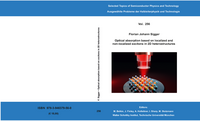
Due to their inherent confinement of charge carriers, transition metal dichalcogenide (TMD) monolayers present an optimal platform for observing excitonic phenomena. A large spin-orbit coupling, in combination with a broken inversion symmetry in the monolayer limit, leads to novel spin-valley physics. The 2D nature of the monolayers leads to large exciton binding energies, causing excitonic effects to dominate the strong light-matter interaction even at room temperature. Advances in the assembly of van der Waals (vdW) heterostructures allow the implementation of TMDs into complex, layered structures, where materials such as few-layer graphene and hBN can act as gate electrodes and insulating dielectric barriers. Furthermore, due to their vdW crystal nature, vdW heterostructures can be easily integrated into existing device designs, such as silicon-based photonic integrated circuits, which hold promise for future applications. In this thesis, we investigate delocalized interlayer excitons (IXs) in TMD hetero-bilayers and localized defect-bound excitons in MoS2. In the first part, we give a detailed introduction to state-of-the-art vdW heterostructure assembly processes and analyze the samples’ interface and optical quality. We continue discussing delocalized interlayer excitons that form due to a type II band alignment of a TMD hetero-bilayer. Large exciton binding energies on the order of 100 meV and a reduced electron-hole wavefunction overlap, leading to lifetimes up to μs, make the system ideal for the exploration of many-body phenomena. We demonstrate several criticalities in the IX phase diagram that we interpret as signatures of a degenerate exciton gas. Furthermore, we present back focal plane imaging of the IX emission and determine an almost entirely in-plane optical transition dipole with < 2 % out-of-plane contribution. In addition to the simple type II band alignment picture, we introduce effects related to the orbital hybridization of the hetero-bilayer band structure. By using the Stark effect to couple to the permanent out-of-plane electric dipole of IXs, we determine different k-space origins for the observed IXs. Due to the hybridization of the bands, the localization of the IXs ranges from strictly interlayer to completely delocalized across the hetero-bilayer. Moreover, we use a hybridization-induced anti-crossing effect to tune the layer localization index of the charge carriers and the lifetime of IXs from 100 ns - 400 ns. Spectroscopic imaging ellipsometry measurements give us access to a broad spectral range of the dielectric function. Especially for higher energetic transitions, such as the C and D exciton resonances, a hetero-bilayer has to be described as a new vdW solid instead of a non-interacting stack of two independent monolayers. Our study on He-ion irradiated MoS2 reveals dose-dependent defect luminescence and amorphization of the flakes at high doses. Via a thermal annealing and encapsulation study, we determine that He-ion-induced luminescence stems from unpassivated sulfur vacancies V1s. DFT calculations show a manifold of sub-gap states related to sulfur vacancies. To access these states not only in emission but also in absorption, we combine He-ion irradiated, encapsulated MoS2 with cavity-enhanced extinction spectroscopy with a resolution of 0.01 %. An ultra-clean device facilitates a correlation of dose-dependent write fields with an increased optical extinction. Hyper-spectral imaging allows us to extract an absorption spectrum and observe the manifold of sub-gap states. Finally, we calculate the single defect absorption as 0.042 %. We present a site-selective on-demand creation of single photon emission centers via a helium ion microscope at a spatial resolution of < 9 nm and a single emission center creation rate of up to 37 % efficiency. We find a strong electron-phonon interaction and demonstrate a single photon emission character with a g(2)(0) = 0.23. Finally, we show that the emission centers are robust against thermal cycling and show low spectral diffusion and few blinking events. Our results demonstrate the extraordinary potential of TMDs in vdW heterostruc- tures for the creation of quantum technology and the observation of fundamental physical effects that have long remained elusive in 3D structures.